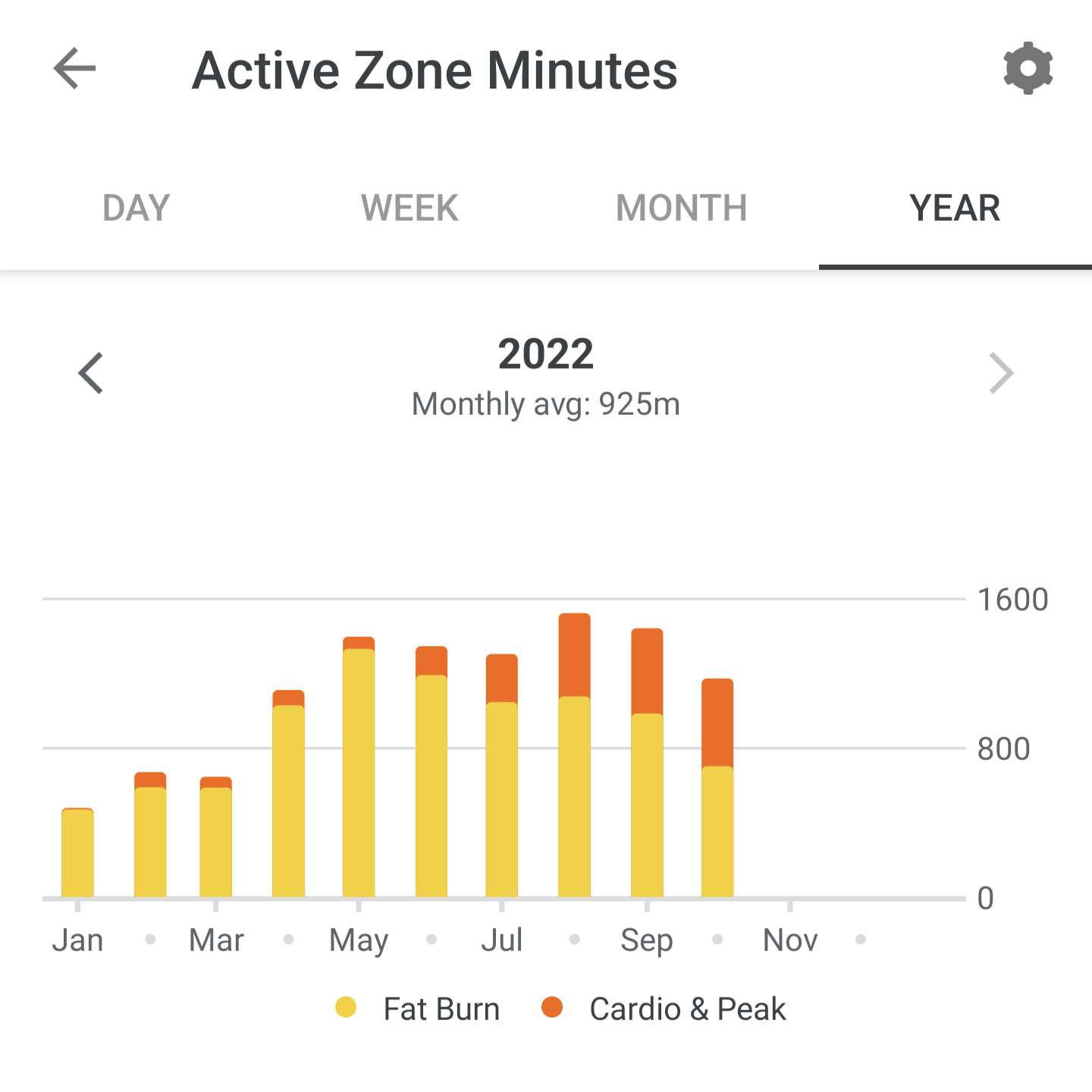Endurance by NonProphet, Part 2
Results of Nonprophet's Endurance Program.
Austin Haedicke
947 Words | Read Time: 4 Minutes, 18 Seconds
2022-10-29 09:00 -0700
This is technical review of the Non-Prophet Endurance Program and the results I achieved. For a more investigative look what changed and challenged me mentally and what I learned in the process, see Part 1.
Tools & Definitions:
The program was 12 Weeks long, with 3 training sessions per week. For me this was on top of 4-5 BJJ sessions / week and (for the first three weeks) one 30-minute strength maintenance session per week.
The program essentially builds volume at a “Zone 2” intensity (65 - 70% MHR). To calculate this, there are some discrepancies in the in the program itself and other tools I had available (FitBit Inspire 2).
- Max Heart Rate = 186 bpm
- MAF Score = 146 bpm (approximately Zone 2)
FitBit uses proprietary formulas, but their general “Zone” categories are:
- “Fat Burn” (~ Zone 1) @ 110 bpm
- “Cardio” (~ Zones 2, 3, 4) @ 140 bpm
- “Peak” (~ Zone 5) @ 167 bpm
Starting Where You’re At:
Start Date: 7/23/22
Because, why not start an endurance program in the middle of summer in the Southeast, USA!
I consider myself generally fit, though that is a loaded question as to what I’m actually “fit” for. Grappling and moderate to heavy lifting; check. Endurance and running; big nope.
Nonprophet’s Endurance Manual offers 3 “tracks”:
- Newb
- Novice
- Specialist
Clearly I belong in the Newb category. This actually works/ed out nicely because my “area of specialty” is grappling, so that’s where I wanted to maintain focus and not have the primary objective overshadowed by the support training.
Of the deficiencies described in the book, I believe myself to struggle with “inability” simply due to my inexperience with prolonged efforts (30, 60, 90 minutes, etc.). Even until this past summer I wasn’t training much “capacity”; so there was very little in the way of conditioning other than strength work off the mat.
Additionally, I skipped the (recommended NEWB only) 2-week acclimation since, as I mentioned, I had at least some confidence in my overall heart and lung capabilities.
How it started vs. how it’s going
Tests & Metrics:
Like all tests / measures these aren’t intended for “training” purposes (e.g. when a test becomes the goal, it ceases to be a good test).
Heart Rate and VO2max:
- Start RHR: 59 bpm (30 day average)
- End RHR: 59 bpm (30 day average)
- Start VO2: 47 - 51 (FitBit estimate)
- End VO2: 47 - 51 (FitBit estimate)
Well, that’s disappointing… FitBit does make their VO2max estimates off of resting heart rate, so the changes (or lack thereof) should and do correspond. I don’t have an explanation for this, other than as I hinted at previously my “fitness” was sufficient, though the training efficiency / experience / infrastructure were not.
Zone 2 Volume:
- FitBit “Cardio” Minutes (January - June): 449 Total
- FitBit “Cardio” Minutes (July - Oct.): 408 Average
I don’t know what this means, but it’s a hellacious delta. From the end of July to the end of October I averaged, in each of those months, almost as many Zone 2+ minutes as I had in the first 6 months of the year combined.
40/400 Score:
- Start Score 7/23/22: 3.68*
- End Score 10/23/22: 4.43
- Delta: 20.38% better
40/400 is 60-minute AMRAP workout alternating between 40 cals on the Assault Bike and a 400m run. Typically this would be “scored” by reps / rounds completed in the given time frame. However, I decided that since the goal was to test efficiency, that one should be “punished” for breaking outside of the prescribed intensity (Zone 2).
So, to compute then:
80 Calories per. Full Round
- Bike Cals (for partial round)
- 1 Cal / 10 meters (for partial round)
= Total Cals
Score = Total Cals / Average Heart Rate
The incentive, then, is to maximize output per rep (bpm) rather than gross output – what you’d call efficiency!
*The start score was aggregated from a 45 minute session; assuming the same pace would have been held for a full 60 minutes. The end test was a full 60-minute AMRAP.
Conclusion:
In 12 weeks, I better have learned a thing or two, and I did (Part 1). I also better see some changes, and I did; but not quite what I expected.
Firstly, time-spent is not equivocal to time-lapsed. That is, every program in this book has 36 training sessions spread over 12 weeks. The time-lapsed is very similar (though the “novice” and “specialist” programs do have increased volume).
Even if two athletes both performed the “NEWB” program as I did, they may not see the same results, or have put forth the same effort in any given, or the aggregate of all, session(s) – how you spent the time (i.e. time-spent).
I “spent” about 408 zone minutes / month for three months (1,200 or so total). That’s more than three times the previous six months *combined.*Where did that expenditure get me? I had planned a non-synthetic benchmark of a notably difficult 30 mile trail “run” in North Carolina. However, the party I had pre-running the course a month prior aborted due to an injury.
That left me with the 40/400 (a “synthetic benchmark”). As calculated, I saw a 20% improvement in my work efficiency during the 1-hour trial. Would I see the same improvement repeating the program? Likely not. As training experience (“age”) increases, a greater stimulus is often required to continue progressing (e.g. what got you where you are won’t get you where you want to go).
Overall, I’d consider the program a huge success. If nothing else, I “endured” 12 weeks of less-than-monotonous endurance training which in itself is an endeavor I’d spent my entire adult life avoiding.

